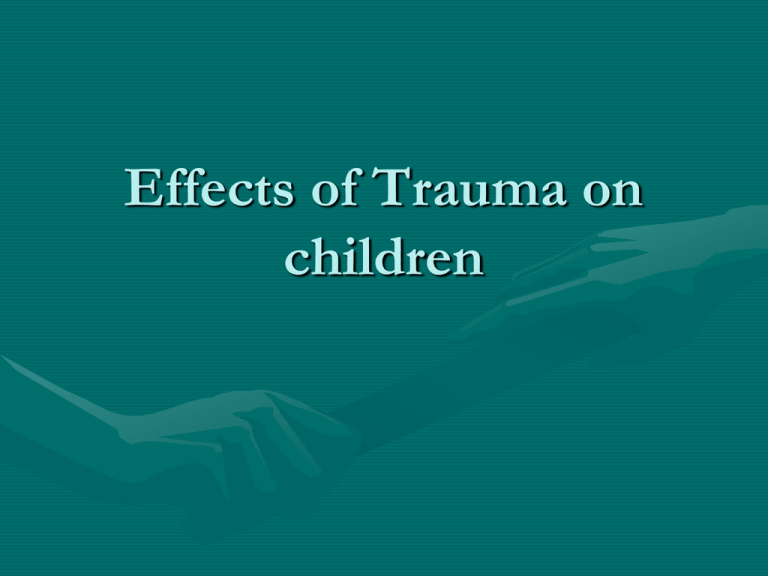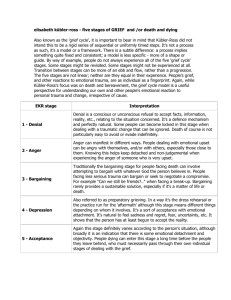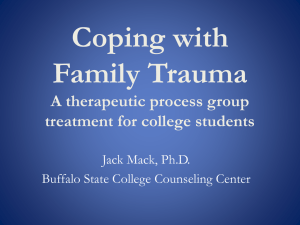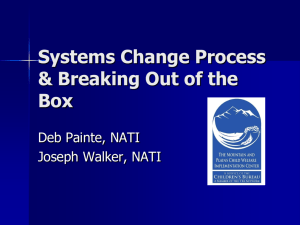Effects of Trauma on children
advertisement

Effects of Trauma on children Trauma-Definition • A wound, hurt, or injury • Physical stress including abuse or neglect • Emotional/psychological neglect or abuse Trauma-types • One-time incidents like accidents, natural disasters, crimes, surgeries, deaths, and other violent events. • Chronic or repetitive experiences such as child abuse, neglect, combat, urban violence, concentration camps, battering relationships, and deprivation. • As traumatic as single-blow traumas are, the traumatic experiences that result in the most serious mental health problems are prolonged and repeated. • The loss of parents, siblings, relatives, friends and neighbors • Institutionalization is a particular type of trauma. Simple vs. compounded • Single—one event • Compounded-many events – Problematic family life + – Institutional life + – Violence or maltreatment in the institution = Emotional/Psychological Effects of Trauma • Overwhelms the individual's perceived ability to cope. – Daily tasks of living – Changes. – Life tasks. • Does not allow a person to grow and develop to their maximum potential. • A person feels emotionally, cognitively, and physically overwhelmed by life experiences. Effects of Trauma of Attachment Behaviors • persistent frequent tantrums • resistance to being held (arches back or is stiff when held) • indiscriminately affectionate with strangers • cruelty to animals and other vulnerable beings • lack of empathy and remorse (no conscience) • Prefers crib or isolation to being held or interacting with others • Very rarely cries, too quiet... too good? • Cries incessantly - very demanding, easily enraged What can we do to prevent truama? System Interventions • Preserve the biological family when ever possible—even children from multi-problem families do better than children in institutions • When not possible, promote kinship family care • If neither of these options can work, foster family care or adoption What can we do?—Child centered interventions (non medical)* • • • • Family placement Establish safety and security Allow children to talk about any event Prepare children for a future * Some traumas have such a negative effect that it can cause significant mental health problems requiring medical as well as Establish safety and security • Respond to and provide opportunities for children to receive positive human physical contact to reaffirm needs for sensory comfort and care. • Help children get enough sleep and nutrition. • Provide them with physical symbols of nurturing, love, or remembrance (life books) Small group discussion • What can you do to help children feel safe and secure in your community? Allow children to talk about any event • Encourage them to tell or develop stories that help them explore intense reactions such as anger or fear. • Reassure them that sadness and grief are a necessary part of surviving. • Only works for older children with language ability; since the language of younger children is behavior, positive behavior management and therapy-based play are better interventions for young children. • Understand grief and loss in children Components of Grief and Loss (not really stages) • • • • 1. SHOCK & DENIAL 2. PAIN & GUILT 3. ANGER & BARGAINING 4. DEPRESSION, REFLECTION, LONELINESS • 5. ACCEPTANCE Small Group Discussion • How can you help children dealing with loss and grief? Prepare children for the future • Encourage the establishment of comforting routines. • Provide them with tangible comfort items: a photograph of a loved one, a stuffed animal, or a favorite blanket. • Help them take time to think about their future. • Support adult caregivers in their efforts to react appropriately. • Work to help children solve problems they face because of the trauma. Small group discussion • In your community, how do you help children prepare for the future? Resilient Children • Resilient children develop strategies for finding older children or adults who might help them. • They will gravitate towards people who seem to provide stability and comfort. • Only a few percent of children are resilient; many will need some help Conclusion • The best way to deal with trauma is to develop a system and services to avoid it • A family-based system of care is better than an institutional-based system of care.











